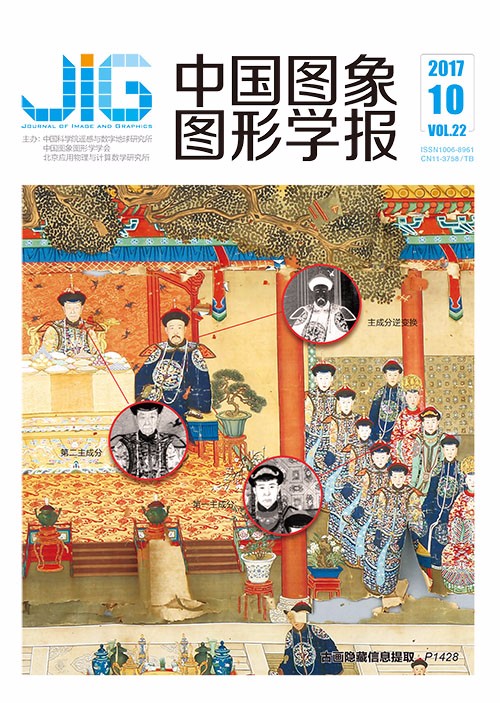
梯度引导的高阶几何彩色图像去噪模型
芦碧波1,2, 李阳1, 王永茂1, 高天玲3(1.河南理工大学计算机科学与技术学院, 焦作 454000;2.广东省数据科学工程技术研究中心, 广州 510631;3.深圳大学数学与统计学院, 深圳 518060) 摘 要
目的 为了消除低阶彩色图像去噪模型产生视觉上不希望得到的"阶梯效应"并提高去噪过程中的边缘保持效果,提出一种黎曼几何驱动的高阶彩色图像去噪模型,并在扩散中使用一阶梯度信息引导高阶信息驱动的扩散,以改善去噪过程中的边界探测和保持能力。方法 在黎曼几何框架下,对低阶彩色图像去噪模型进行分析,并由面积微元出发得到对应的二阶微分形式,利用二阶导数矩阵的Frobenius范数构造高阶彩色图像变分能量泛函,由此得到一个彩色图像去噪的高阶扩散模型。为在扩散中保持边界,使用高斯卷积后的一阶梯度信息引导高阶扩散,得到一个多通道耦合的高阶非线性彩色图像去噪模型。分析表明,该模型在扩散时兼顾了单通道和多通道、低阶和高阶等多种信息之间的关系进行耦合去噪。结果 在实验中对不同噪声水平下的1维彩色信号、合成彩色图像和标准彩色测试图像进行去噪,并使用峰值信噪比(PSNR)与结构相似性(SSIM)作为客观评价指标,将本文结果与相关彩色图像去噪扩散模型的结果进行对比。在不同噪声水平下本文模型去噪结果的平均PSNR与相关模型相比提高了2.33%,平均SSIM提高了0.4%。结论 本文模型能够有效去除彩色图像中不同噪声水平的高斯白噪声,能较好消除视觉上的"阶梯效应",得到分片线性光滑的彩色图像,同时还能够较好保持图像边界信息。
关键词
Gradient guided higher-order model based on Riemann geometry for color image denoising
Lu Bibo1,2, Li Yang1, Wang Yongmao1, Gao Tianling3(1.College of Computer Science and Technology, Henan Polytechnic University, Jiaozuo 454000, China;2.Guangdong Engineering Research Center for Data Science, Guangzhou 510631, China;3.College of Mathematics and Statistics, Shenzhen University, Shenzhen 518060, China) Abstract
Objective Image degradation is commonly unavoidable during acquisition and noise makes the later processing difficult and inaccurate.Partial differential equation methods,especially low order methods,are efficient for grey-scale images denoising.Instead of the heuristic channel-coupled method,researchers begin to deal with color images under Riemann geometry framework.This framework uses the arc element to measure the rates of change and the eigenvectors of the metric tensor to describe the direction of the change.However,these methods generate low-order partial differential equations and their extension to the higher-order model remains an important challenge.The high-order models have ability to eliminate the undesired staircasing effect that accompanies the use of a model based on first-order derivatives.In this paper,a geometry-driven higher-order model for removing noise from color images is proposed.The proposed method introduces a gradient-based weigh function to improve edge detection and preserving ability while removing noise.Method Within the Riemann geometry framework,the norm of the arc element is calculated and generates a quadratic form called the first fundamental form.This norm can be interpreted as the distance of the ellipse to its center.The eigenvalues of the metric tensor correspond to the semi-major axis and the semi-minor axis of that ellipse.Therefore,its Jacobian matrix allows the measurement of edges in the vector-valued images.Various matrix norms can be established based on this matrix to characterize reasonable measurement for constructing variational models for color image denoising.However,as a low-order model,its corresponding low-order partial differential equation also suffers from staircasing effect.Inspired by the low-order model,a second-order equation is derived from the area element within the geometrical framework for image processing.Its norm square is decided by a second-order-based matrix and the Frobenius norm for this matrix is obtained.Based on this special norm,a higher-order variational model is proposed and a high-order partial differential equation is derived using variational principal.The gradient information is used to guide the higher-order diffusion to preserve edges during the diffusion process.The gradient is first convoluted by Gaussian kernel to predict edge locations to reduce the effect by additive Gaussian white noise.Analysis on the nonlinear diffusion term shows that the diffusion is controlled by the following information:the guide information based on first-order derivatives,the diffusion information based on second-order derivatives,and the second-order derivatives ration between the single-color channel and three-color channels.Result Experiments are conducted for various data,including one-dimensional signal, synthetic images,and standard test images.In every experiment,the test data are corrupted by additive white Gaussian noise with different variances.The results obtained by the proposed model are quantitatively and visually compared with the related methods.Peak signal-to-noise ratio(PSNR) and structure similarity index(SSIM) are used for quantitative comparison.Zoomed images and residual images are used for visual comparisons.The ability of recovering piecewise linear is verified for one-dimensional synthesized signal.The proposed method has an obvious improvement in both objective index and visual perception.The PSNR of the recovered signal processed by the proposed method increases from 32.64 dB to 33.16 dB compared with the low-order model when the standard deviation of the noise is 35.The SSIM result of the proposed method increases from 0.969 5 to 0.991 8 compared with the channel-coupled mean curvature method under the same condition.The proposed method is also compared with the decorrelated vectorial total variation model.The PSNR increases by 1.37 dB,and the SSIM increases by 0.005 8.The proposed method has the best objective index compared with related methods.The results are plotted in the cubic RGB color space.The same color is mapped to the same point in this space,and the linear segments in the RGB space correspond to the smoothing change of color.The result of the proposed method gives the best performance in the recovery of both constant area and the linear part of the noisy signal.Experimental results on a set of color image data are also given.Compared with the current related methods,the average improvement is 2.33% for PSNR and 0.4% for SSIM.Conclusion The proposed model can suppress noise efficiently from a piecewise linear image while avoiding the staircasing effect and giving a better performance at the edge of the color image.The proposed method is efficient for removing noise with different variances.
Keywords
color image denoising higher-order partial differential equation Riemann Geometry gradient guided multichannel coupling
|



 中国图象图形学报 │ 京ICP备05080539号-4 │ 本系统由
中国图象图形学报 │ 京ICP备05080539号-4 │ 本系统由